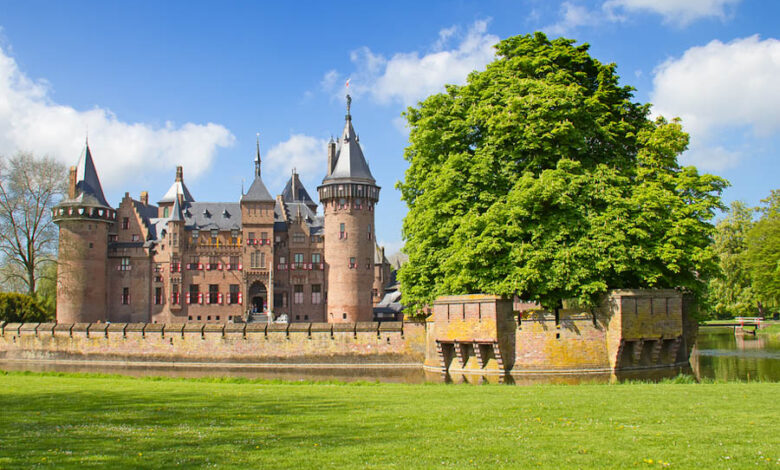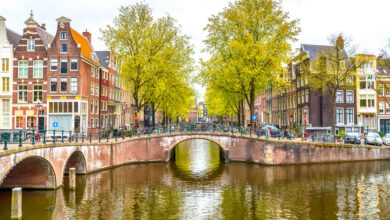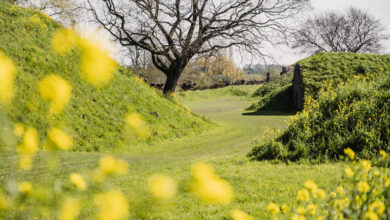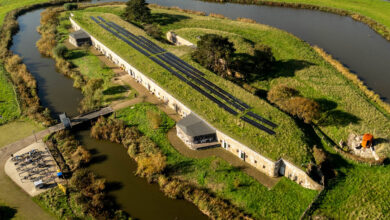
Castles and palaces, deeply rooted in Dutch history
The Netherlands is home to a remarkable array of castles and palaces. These architectural marvels stand as witnesses to the country’s regal past and offer a glimpse into the lives of its former inhabitants. Join us on a virtual journey as we uncover the captivating history and charm of some of the most famous castles and palaces in the Netherlands.
The story behind Dutch Castles and Palaces
The construction of Dutch castles and palaces is deeply rooted in the country’s cultural, political and economic history. These impressive buildings served various purposes throughout different periods.
One significant reason for building castles was defense and security. Given the Netherlands’ geography, which includes rivers, lakes and coastal regions, castles were strategically positioned to protect against invasions and raids. They featured defensive elements such as elevated locations, moats, thick walls, towers and drawbridges, offering safety during times of conflict.
Castles and palaces were also symbols of power and prestige. The ruling classes used these structures to showcase their wealth and authority. Lavish interiors, fine artworks and opulent furnishings displayed their social standing. The architectural design and ornate details were meant to impress visitors, while the surrounding landscapes often included meticulously designed gardens and parks.
As peace prevailed, castles transformed into more comfortable and luxurious residences. They evolved from fortresses into dwellings with larger living quarters, banquet halls, chapels and gardens. Palaces, specifically built as opulent residences for monarchs and their families, boasted grand reception rooms, state apartments and private quarters, reflecting the prevailing architectural styles of the time.
Furthermore, castles and palaces served as centers of governance and administration. They housed government offices, courtrooms and meeting spaces, playing a crucial role in the governance of the Dutch provinces. These structures were not only residences for rulers but also the focal points of political and social activities.
Additionally, Dutch rulers often constructed hunting lodges and summer retreats in picturesque locations. These smaller residences, surrounded by forests or parks, provided a peaceful setting for recreational activities like hunting. While simpler in design compared to grand palaces, these lodges still exuded architectural elegance and natural beauty.
Dutch Castles and Palaces in these days
Over time, the functions and designs of Dutch castles and palaces have evolved, reflecting changing architectural trends, political landscapes and societal norms. Today, many of these magnificent structures are open to the public, allowing visitors to explore and appreciate the rich history, art and architecture that define the Dutch castle and palace heritage. Well-known castles and palaces in the Netherlands today are:
Kasteel Muiderslot
Situated near the town of Muiden (Noord-Holland), the Kasteel Muiderslot is one of the most iconic and well-preserved medieval castles in the country. Built in the 13th century, it served as a defensive stronghold and later as a residence for Dutch nobility. The castle’s impressive towers, moat and drawbridge evoke a sense of enchantment. Today, visitors can explore its furnished rooms, beautiful gardens and the interactive exhibits that bring its history to life. Buy your ticket for Muiderslot >>>
Paleis Het Loo
Located in Apeldoorn (Gelderland), Paleis Het Loo is a magnificent 17th-century royal palace surrounded by exquisite gardens and woodlands. Originally a hunting lodge, it was transformed into a grand palace by King William III and Queen Mary II of England. The palace features opulent interiors including the stunning Ballroom and the King’s and Queen’s apartments. Visitors can also wander through the meticulously manicured gardens, which are designed in the classic Baroque style. Buy your ticket for Paleis Het Loo >>>
Kasteel De Haar
Kasteel De Haar, situated in the province of Utrecht, is a fairytale-like fortress that epitomizes grandeur and splendor. Originally built in the 14th century, it was extensively renovated and expanded in the late 19th century, resulting in its current Neo-Gothic style. The castle boasts lavish interiors, a beautiful chapel and extensive parklands. With its stunning turrets, drawbridges and surrounding moat, Kasteel De Haar offers visitors an immersive experience into the world of aristocratic life. Buy your ticket for Kasteel De Haar >>>
Kasteel Radboud
Overlooking the charming town of Medemblik (Noord-Holland), Kasteel Radboud stands as a testament to the medieval history of the region. Built in the 13th century, the castle was primarily a defense fortress against invaders. It played a crucial role in protecting the region’s waterways and land. Today, visitors can explore its ancient walls, visit the museum inside and learn about the castle’s role in the past through various exhibits and artifacts. Buy your ticket for Kasteel Radboud >>>
Paleis Noordeinde
Situated in The Hague (Zuid-Holland), Paleis Noordeinde is the official workplace of the Dutch king and one of the few royal palaces still in use by the Dutch royal family. Dating back to the 16th century, the palace has undergone several renovations and expansions over the years. Although not open to the public, visitors can marvel at its stunning facade, picturesque gardens and the Changing of the Guard ceremony that takes place nearby. Noordeinde Palace is open to the public for a few days almost every year in the summer.
Slot Loevestein
Situated in the province of Gelderland, Slot Loevestein is a medieval castle that served as a strategic fortress and later as a state prison. Its most famous prisoner was Hugo Grotius, a renowned Dutch philosopher and scholar. Visitors can explore the castle’s fortified walls, towers and enjoy panoramic views of the surrounding countryside. Buy your ticket for Slot Loevestein >>>
Kasteel Doorwerth
Nestled in the forests of Gelderland near Arnhem, Kasteel Doorwerth is a picturesque castle with a rich history dating back to the 13th century. The castle witnessed numerous battles and underwent several transformations throughout the centuries. Today, it serves as a museum showcasing art, weaponry and artifacts from different eras. Buy your ticket for Kasteel Doorwerth >>>
Kasteel Het Oude Loo
Situated in the heart of the Kroondomeinen, Het Oude Loo is a royal hunting lodge near Apeldoorn in Gelderland. Originally built in the 15th century, it has served as a summer residence for members of the Dutch royal family. Surrounded by beautiful gardens and a deer park, the lodge showcases elegant interiors and offers a glimpse into royal leisure.
Paleis Huis ten Bosch
Located in The Hague (Zuid-Holland), Huis ten Bosch is one of the three official residences of the Dutch royal family. Constructed in the 17th century, it features classic Dutch architecture and picturesque gardens. While not regularly open to the public, visitors can admire the palace’s exterior and explore the surrounding park. Paleis Huis ten Bosch is the official residence of the king and his family.
Kasteel Amerongen
Situated in the village of Amerongen (Utrecht), Kasteel Amerongen is a stately castle that played a significant role in Dutch history. It was a meeting place during the negotiations of the Treaty of Utrecht in 1713, marking the end of the War of Spanish Succession. The castle’s interior showcases richly decorated rooms including the impressive Knight’s Hall. Buy your ticket for Kasteel Amerongen >>>
These are just a few examples of the many castles and palaces that grace the Netherlands. Each one carries a unique history and architectural style, providing visitors with a fascinating glimpse into the country’s past. Exploring these majestic structures is like stepping into a bygone era, where tales of knights, nobles and royalty come alive.



